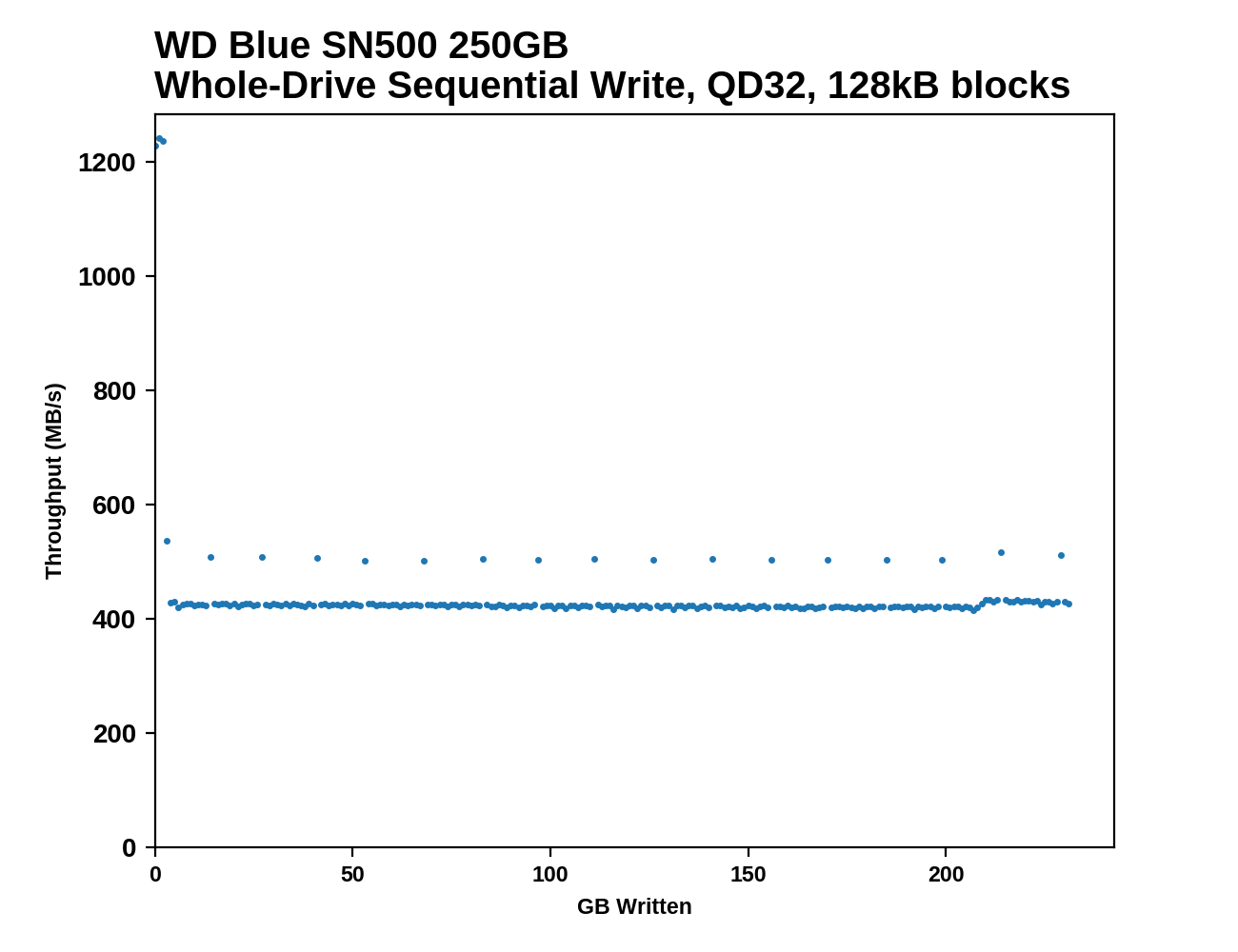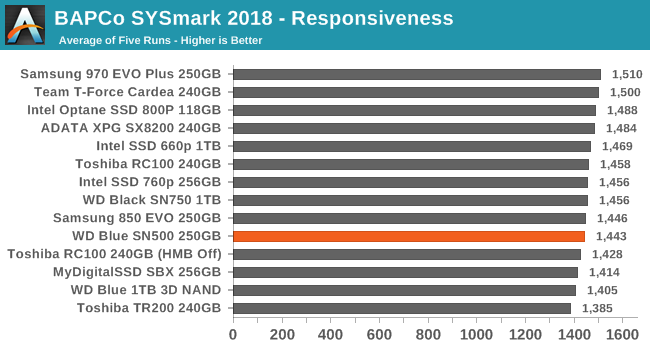The Western Digital WD Blue SN500 SSD Review: Moving The Mainstream To NVMe
by Billy Tallis on April 19, 2019 9:30 AM ESTWhole-Drive Fill
This test starts with a freshly-erased drive and fills it with 128kB sequential writes at queue depth 32, recording the write speed for each 1GB segment. This test is not representative of any ordinary client/consumer usage pattern, but it does allow us to observe transitions in the drive's behavior as it fills up. This can allow us to estimate the size of any SLC write cache, and get a sense for how much performance remains on the rare occasions where real-world usage keeps writing data after filling the cache.
 |
|||||||||
The 250GB WD Blue SN500's SLC write cache lasts for a mere 3GB before the write speed drops down to SATA speeds. After the cache is exhausted, the write speed is very consistent, with periodic short of higher performance that last for less than 1GB.
 |
|||||||||
| Average Throughput for last 16 GB | Overall Average Throughput | ||||||||
The SN500's sustained sequential write speed of about 432MB/s doesn't make much use of the speed offered by the PCIe host connection, but it's very good for a drive in this capacity class: the Samsung 970 EVO Plus is barely any faster, though its SLC cache is much larger. None of the other low-end NVMe drives we've tested come close to sustaining the long-term write performance that the SN500 provides.
Working Set Size
Most mainstream SSDs have enough DRAM to store the entire mapping table that translates logical block addresses into physical flash memory addresses. DRAMless drives only have small buffers to cache a portion of this mapping information. When accessing a logical block whose mapping is not cached, the drive needs to read the mapping from the full table stored on the flash memory before it can read the user data stored at that logical block. This adds extra latency to read operations and in the worst case may double random read latency.
We can estimate the size of any on-controller mapping buffer by performing random reads from different sized portions of the drive. When performing random reads from a small slice of the drive, we expect the mappings to all fit in the cache, and when performing random reads from the entire drive, we expect mostly cache misses.
When performing this test on mainstream drives with a full-sized DRAM cache, we expect performance to be generally constant regardless of the working set size, or for performance to drop only slightly as the working set size increases.
 |
|||||||||
The SN500 offers good random read IOPS for working set sizes up to about 4GB before performance begins to decline. Based on the usual ratio of requiring 1MB of mapping data cache per GB of storage, it looks like the SN500's controller devotes around 4MB of SRAM to this purpose. That's significantly smaller than the typical Host Memory Buffer sizes used by DRAMless NVMe SSDs that implement that feature. For example, the Toshiba RC100 uses an HMB of 38MB and maintains random read performance out to at least 24GB working set sizes.
While the SN500's cache of address mapping data may be rather small, it is clearly plenty fast: for small working set sizes, the SN500's random read performance is higher than the WD Black SN750.
BAPCo SYSmark 2018
BAPCo's SYSmark 2018 is an application-based benchmark that uses real-world applications to replay usage patterns of business users, with subscores for productivity, creativity and responsiveness. Scores represnt overall system performance and are calibrated against a reference system that is defined to score 1000 in each of the scenarios. A score of, say, 2000, would imply that the system under test is twice as fast as the reference system.
SYSmark scores are based on total application response time as seen by the user, including not only storage latency but time spent by the processor. This means there's a limit to how much a storage improvement could possibly increase scores, because the SSD is only in use for a small fraction of the total test duration. This is a significant difference from our ATSB tests where only the storage portion of the workload is replicated and disk idle times are cut short to a maximum of 25ms.
| AnandTech SYSmark SSD Testbed | |
| CPU | Intel Core i5-7400 |
| Motherboard | ASUS PRIME Z270-A |
| Chipset | Intel Z270 |
| Memory | 2x 4GB DDR4-2666 CL15 |
| Case | In Win C583 |
| Power Supply | Cooler Master G550M |
| OS | Windows 10 64-bit, version 1803 |
Our SSD testing with SYSmark uses a different test system than the rest of our SSD tests. This machine is set up to measure total system power consumption rather than just the drive's power.
 |
|||||||||
| Creativity | Productivity | Responsiveness | Overall | ||||||
Only the Responsiveness subscore shows a meaningful difference between SSDs of similar capacities, and even then the difference between the top NVMe drives and the slowest DRAMless SATA drives is fairly small. The WD Blue SN500's Responsiveness score is a bit slower than average for this bunch of SSDs, but as more of an entry-level NVMe drive this isn't a disappointment for the SN500.
Energy Usage
The SYSmark energy usage scores measure total system power consumption, excluding the display. Our SYSmark test system idles at around 26 W and peaks at over 60 W measured at the wall during the benchmark run. SATA SSDs seldom exceed 5 W and idle at a fraction of a watt, and the SSDs spend most of the test idle. This means the energy usage scores will inevitably be very close. A typical notebook system will tend to be better optimized for power efficiency than this desktop system, so the SSD would account for a much larger portion of the total and the score difference between SSDs would be more noticeable.

The WD Blue SN500 is one of the most efficient NVMe drives in its capacity class, but the SATA drives still take all the top scores for energy consumption over the course of a SYSmark run. There are several faster NVMe drives that have power requirements only slightly above the SN500 despite including the DRAM cache the SN500 lacks.










50 Comments
View All Comments
kpb321 - Friday, April 19, 2019 - link
A lot of people don't need much space. I just upgraded my wife from a 128gb SSD to a 256gb SSD. The 128GB SSD was getting a little full because of pictures of our son and I was occasionally having to free up space for Windows update etc. We could have stuck with the 128gb and migrated her entire picture collection to the NAS or kept freeing up space when needed but a 256 SATA SSD is so cheap I figured why not upgrade. Her old 128gb got stuck in my in-law's computer to replace the old slow 500gb hd they had in the system. They are using less than half the space on that SSD so should be fine for a long time and if really needed I can always setup the 500gb hd as a secondary storage drive for them. The old days of 32/64gb SSD being barely adequate are passed. Windows + a decent selection of apps is fine on a 128gb SSD and 256gb gives even more head room.jabber - Saturday, April 20, 2019 - link
Been running my work laptop on a 64GB SSD for several years now. Some of us don't need to keep masses of data on a device that goes out and about. Sometimes carrying masses of data is a liability.RealBeast - Friday, April 19, 2019 - link
Don't know about mainstream, but no way that I would waste precious M.2 slots on some small slow drive like this one.Sure a .5-2TB, but not really a 660P for me (they should be on SATA ports at my house). I use those ports for fast drives.
beginner99 - Saturday, April 20, 2019 - link
In a laptop you might have a point but in a desktop? Put the OS on it and the most used apps like browser. If you don't game you are already set. For games you can use a hdd or a large cheap sata ssd as it doesn't really matter much what you use.stephenbrooks - Sunday, April 21, 2019 - link
If you have a lot of games you'll want both large capacity and fast access.But other than capacity, this "low end" NVMe drive looks great. It's clearly possible for them to do 1TB+ versions in the future too, in one way or another.
Korguz - Sunday, April 21, 2019 - link
fazalmajid you may not see it.. but others do.. for me.. i usually use a small drive for my C drive, aka windows drive, before it was 120, now.. as 120 gig drives have next to vanished, im using 250 gig drives, with other bigger drives for other things.. so when it come times for format, and install fresh.. instead of having to move and then redo a big drive.. all i have to deal with, is a small drive with little to no " i want to keep this so i need to move it to another drive " swapping...stephenbrooks - Sunday, April 21, 2019 - link
I found Windows wants to put "User" data and "Program Files" on the same primary drive, so it can grow in size and even end up containing data I want to keep, even if I try to separate the two.Korguz - Monday, April 22, 2019 - link
i check those 2 directories as part of the " i want to keep this so i need to move it to another drive " searching, and then moving... :-)tipoo - Friday, April 19, 2019 - link
I'd still be interested in seeing a T2 SSD (Apple) put through these paces. Usually they did great in sequential tests but not so much in 4k randoms, so I wonder how it would do on, say, Destroyer.kpb321 - Friday, April 19, 2019 - link
This drive did exceed my expectations for a x2 pci-e lanes with no Dram and no HBM but the pricing is going to be key. The SM2262 drives have gotten pretty inexpensive and don't leave a lot of room for a drive like this even as good as it may be for what it is. I just recently picked up the ADATA version of the HP EX920 @ $73 for the 480gb drive. That a x4 drive with dram on it and should beat this drive pretty consistently. Personally this drive would need to be down around $60 before I'd consider the price difference meaningful enough to consider this drive.